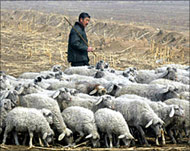Ethnic clashes erupt in central China
An unknown number of people have been killed in violent clashes between the Muslim Hui minority and the Han majority in central China’s Henan province.

According to a report in The New York Times, which could not be immediately confirmed, as many as 148 died in the violence, including 18 police officers dispatched to put down the unrest.
Other reports, quoting local residents, put the toll at at least seven.
Martial law has now been imposed on the area, near the major city of Zhengzhou.
Nanren village, near the southern bank of the Yellow river, was one of the flashpoints of the confrontation, which had not yet been quelled, according to the imam of the village mosque.
“Two Huis died here, and four or five members of the Han nationality,” the imam, surnamed Hu, said.
He said the clash erupted late last week when Hui truck drivers from Nanren tried to pass through a village mostly inhabited by Han Chinese and one of them got beaten up over a traffic dispute.
Houses torched
Soon after that incident, thousands of Han Chinese surrounded Nanren village, and a confrontation developed in which a number of houses were burned down and a brick factory was destroyed, Hu said.
 |
|
Eighteen police officers may |
The fatalities that Hu was informed about happened during this clash, which was only put down when troops from the regular and paramilitary People’s Armed Police arrived, he said.
He said he had heard vague reports of a similar clash in another nearby village on Sunday, although he said he had no details.
A female officer in the area’s main police station said she was one of the few left as her colleagues were out trying to control the disturbances.
“Normally, there are several hundred police here, but they have all gone to the scene,” she said. “The People’s Armed Police has also gone to the scene.”
Some locals doubted the high casualty figure.
Toll unclear
“Nearly 150 dead sounds like too much,” said a local reporter. “Maybe it’s the number of casualties, dead and injured put together.”
 |
|
Disputes over rights to farmland |
The New York Times offered a different explanation of the confrontation than the imam’s, saying it erupted when a Hui taxi driver fatally struck a six-year-old Han Chinese girl.
Chinese state media on Monday carried no report about the clashes, and local journalists in the region said a news blackout was in force.
“We want to report about it, but the central government doesn’t want us to,” said a journalist with Henan Daily. “They are afraid to trigger conflict among the ethnic groups.”
China’s Huis are descendants of Arab and Persian traders who have over the centuries mixed so thoroughly with the Han Chinese that they are virtually indistinguishable from each other apart from different customs and dress codes.
Occasional clashes
|
|
The Huis are generally considered among China’s best assimilated minorities, although occasional clashes with other groups are known to occur.
Han Chinese make up more than 90% of China’s 1.3 billion people. The country has 55 officially recognised ethnic groups.
In early 2002, ethnic Huis clashed with Tibetans in a rural county of north-western Qinghai province, leading to a large number of injuries and a legal aftermath in which several Huis were sentenced to long jail terms.
Ethnic tensions are aggravated in many parts of China’s poor countryside, home to about 800 million people, by disputes over rights to scarce farmland and control of lucrative government posts.
China suffers occasional tensions between ethnic groups, but the extent of any violent clashes is unclear because the communist government suppresses information about social conflict.